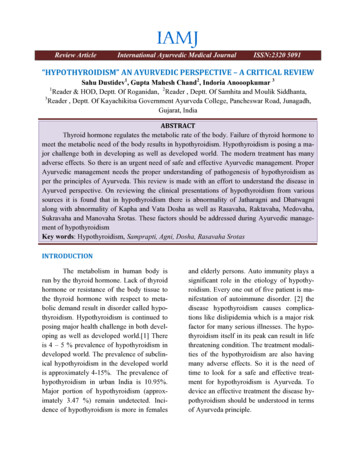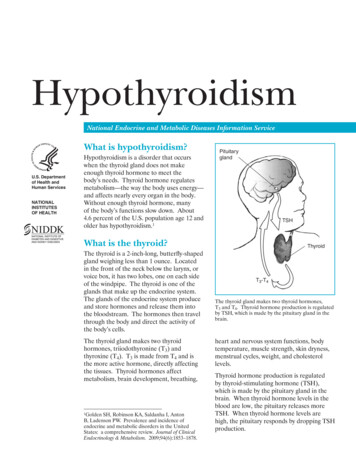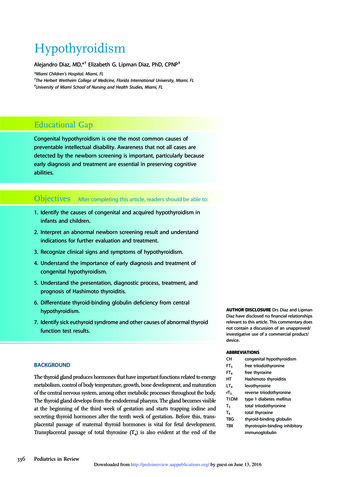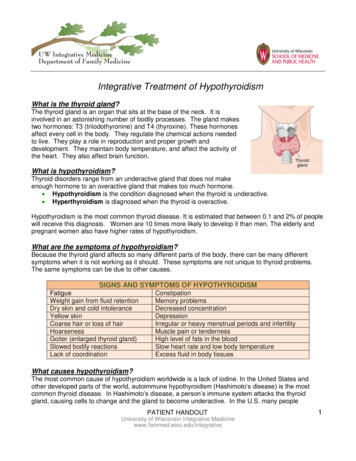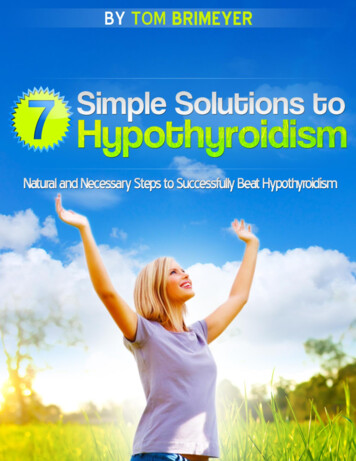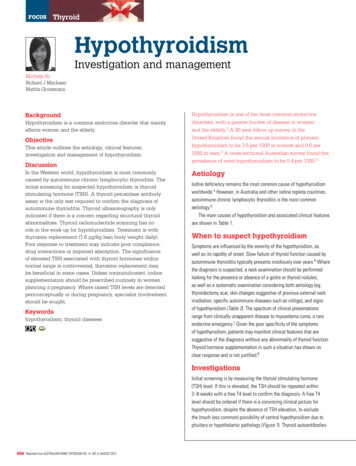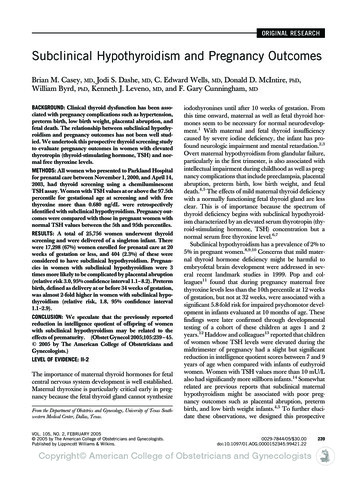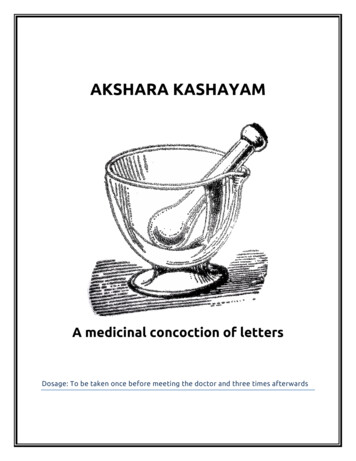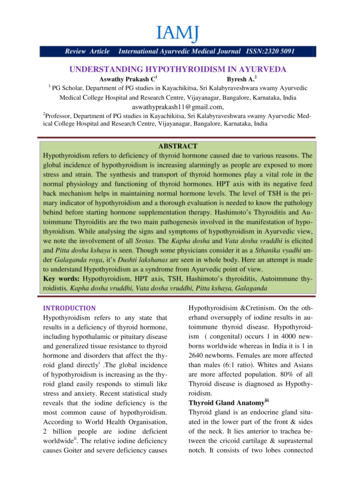
Transcription
Review ArticleInternational Ayurvedic Medical Journal ISSN:2320 5091UNDERSTANDING HYPOTHYROIDISM IN AYURVEDAAswathy Prakash C1Byresh A.21PG Scholar, Department of PG studies in Kayachikitsa, Sri Kalabyraveshwara swamy AyurvedicMedical College Hospital and Research Centre, Vijayanagar, Bangalore, Karnataka, Indiaaswathyprakash11@gmail.com,2Professor, Department of PG studies in Kayachikitsa, Sri Kalabyraveshwara swamy Ayurvedic Medical College Hospital and Research Centre, Vijayanagar, Bangalore, Karnataka, IndiaABSTRACTHypothyroidism refers to deficiency of thyroid hormone caused due to various reasons. Theglobal incidence of hypothyroidism is increasing alarmingly as people are exposed to morestress and strain. The synthesis and transport of thyroid hormones play a vital role in thenormal physiology and functioning of thyroid hormones. HPT axis with its negative feedback mechanism helps in maintaining normal hormone levels. The level of TSH is the primary indicator of hypothyroidism and a thorough evaluation is needed to know the pathologybehind before starting hormone supplementation therapy. Hashimoto’s Thyroiditis and Autoimmune Thyroiditis are the two main pathogenesis involved in the manifestation of hypothyroidism. While analysing the signs and symptoms of hypothyroidism in Ayurvedic view,we note the involvement of all Srotas. The Kapha dosha and Vata dosha vruddhi is elicitedand Pitta dosha kshaya is seen. Though some physicians consider it as a Sthanika vyadhi under Galaganda roga, it’s Dushti lakshanas are seen in whole body. Here an attempt is madeto understand Hypothyroidism as a syndrome from Ayurvedic point of view.Key words: Hypothyroidism, HPT axis, TSH, Hashimoto’s thyroiditis, Autoimmune thyroidistis, Kapha dosha vruddhi, Vata dosha vruddhi, Pitta kshaya, GalagandaINTRODUCTIONHypothyroidism refers to any state thatresults in a deficiency of thyroid hormone,including hypothalamic or pituitary diseaseand generalized tissue resistance to thyroidhormone and disorders that affect the thyroid gland directlyi .The global incidenceof hypothyroidism is increasing as the thyroid gland easily responds to stimuli likestress and anxiety. Recent statistical studyreveals that the iodine deficiency is themost common cause of hypothyroidism.According to World Health Organisation,2 billion people are iodine deficientworldwideii. The relative iodine deficiencycauses Goiter and severe deficiency causesHypothyroidisim &Cretinism. On the otherhand oversupply of iodine results in autoimmune thyroid disease. Hypothyroidism ( congenital) occurs 1 in 4000 newborns worldwide whereas in India it is 1 in2640 newborns. Females are more affectedthan males (6:1 ratio). Whites and Asiansare more affected population. 80% of allThyroid disease is diagnosed as Hypothyroidism.Thyroid Gland AnatomyiiiThyroid gland is an endocrine gland situated in the lower part of the front & sidesof the neck. It lies anterior to trachea between the cricoid cartilage & suprasternalnotch. It consists of two lobes connected
Aswathy Prakash C& Byresh A.: Understanding Hypothyroidism In Ayurvedaby isthmus weighs 12-20gm (5cm x 2.5cm x 2.5cm). It is a highly vascular deepneck structure which is soft in consistencyan lies against C5, C6, C7, T1. The arterialsupply is from superior & inferior thyroidaterteries which are in turn supplied byexternal carotid and subclavian arteriesrespectively. The venous drainage is in tosuperior, middle and inferior thyroid veinswhich drains in to Internal jugular vein andBrachiocephalic vein.Lymph drains in todeep cervical lymph nodes. Nerve supplyis from middle, superior and inferior cervical ganglion.Along with thyroid glandthere are 4 parathyroid glands which arelocated at the four posterior poles of thyroid gland. Thyroid gland is larger in females and increases in size during pregnancy & menustration.Thyroid Gland Histology ivIODIDEIODIDEThyrroid gland consists of numerous spherical follicles composed of thyroidfollicular cells. Colloid, a proteinaceousfluid containing large amounts of thyroglobulin which is the protein precursorof thyroid hormones. The follicular cellssecrete Triiodothyronin T3 & Tetraiodothyronin(Thyroxine) T4.In between follicular cells, the parafollicular cells are present,which secrete calcitonin. T3& T4 areiodine containing derivatives of aminoacidtyrosine.Synthesis of Thyroid hormonesIt consists of mainly 5 steps viz.,1. Thyroglobulin secretion2. Idodide pump3. Oxidation of Iodide4. Iodination of Tyrosine5. ICULAR CELLMONOIODOTYROSINE(DI-IODOTYROSINEMIT DITDIT DITT3TRI IODOTHYRONINETETRA IODOTHYRONINET4Transport of Thyroid hormones inbloodThe 80 % of thyroid hormones aretransported by Thyroxine binding globulinand 10% by Albumin and Transthyretin (Thyroxine binding prealbumin) respectively.Any defect in the stages of synthesis ortransport of thyroid hormones will eventually result in Hypothyroidism.Functions of Thryroid Hormones v Growth & development- for normalaxonal & dendritic development mye-2350www.iamj.in lination & linear growth with maturation of growing epiphyseal end plates.Energy Metabolism- stimulates BMR,oxygen consumption & heat production.Nervous system-It regulates nervoussystem activity by exerting effect onadrenergic receptors.Heart- T3 maintains normal myocardial contractility.Muscle- normal skeletal muscle function is regulated.IAMJ: Volume 3; Issue 11; November- 2015
Aswathy Prakash C& Byresh A.: Understanding Hypothyroidism In Ayurveda Respiratory system- Lung volume andbreathing capacity is maintained Skin-Normal cutaneous circulation &secretion of glands. Colon- helps in controlling normalbowel movements. Vitamins- increases utilization & clearance of vitamins. Carbohydrate metabolism -stimulatesabsorption of glucose from intestine. Protein metabolism- increases the synthesis of proteins in the cells. Fat metabolism- decreases fat storageby mobilizing it and converting in tofree fatty acid. Action on sleep – Hyposecretion ofhormone causes excess sleep and hypersecretion causes sleeplessness. Action on sexual function – helps innormal sexual development & reproductive function.HPT AXISHypothalamo- Piturary- Thyroidaxis regulates the secretion of Thyroidhormones by the negative feed back mechanism. Hypothalamus secretes Thyrotropinreleasing hormone (TRH) which stimulatesAnterior pituitary which in response secretes Thyroid Stimulating hormone(TSH). TSH stimulates Thyroid gland tosecrete Thyroid hormones T3 & T4. Whenthe level of T3 & T4 exceeds the normallimit, it send negative feedback to Anterior2351www.iamj.inpituitary which inturn reduces the secretion of TSH.Pathogenesis of Hashimoto’s Thyroiditisvi: The Lymphocytic infiltration in thyroid follicles causes the germinal centreformation. The atrophy of follicles resultsin oxyphil metaplasia. The absence of colloid matter and fibrosis happens whicheventually leads to Atrophic thyroiditis.Pathogenesis of Autoimmune hypothyroidismvii: The pathogenesis of autoimmune hypothyroidism is uncertain. Various hypothesis for etiological factors arecombination of genetic and environmentalfactors, HLADR polymorphism, T cellregulatory gene, sex steroid effects, Immunological effects, Direct thyroid toxicity, congenital rubella infection, Thyroidlymphocyte infiltrate, Antibodies to Thyroglobulin and Thyroid peroxidise enzyme.Signs: The signs of hypothyroidism include Dry &coarse skin ,Cool extremities,Myxedema, Diffuse alopecia, Bradycardia,Peripheral edema, Delayed tendon reflexes, Carpel Tunnel syndrome and Serous cavity effusions.Symptoms: The symptoms of hypothyroidism include Tiredness, weakness, Dryskin, Feeling cold, Hair loss, Difficulty inconcentrating, Poor memory, ImpairedHearing, Constipation ,Weight gain withpoor appetite, Dyspnea, Hoarse voice,Menorrhagia and Paresthesia.IAMJ: Volume 3; Issue 11; November- 2015
Aswathy Prakash C& Byresh A.: Understanding Hypothyroidism In AyurvedaEvaluation of Hypothyroidism when patients with above signs and symptomsLevel of TSH : 0.0- Hyperthyroidism,0.4- 2.5- Normal range, 2.6-4.0- Atrisk, 4.1-10.0- HypothyroidismTreatment: The modern treatment ishormone replacement therapy by Levothyroxine . The daily replacement is neededie.1.6µg/Kg body weight( average 100150µg. Levothyroxine is Synthetic T4 under brand names Levothyroid, Levoxyl,Synthyroid, Tirosint, Unithroid, Thyronorm, Eltroxin, Cytomel, Thyrolar. The. INVOLVEMENT OF TRIDOSHAtreatment is accompanied with a host of sside effects like High Blood Pressure, Infertility,Weight Loss, Impaired Diastolicfunction and exercise capacity, IncreasedIntima media thickness and Increased riskof coronary heart disease.ANALYSIS OF HYPOTHYROIDISMIN AYURVEDIC VIEW: In CharakaSamhita, Ashta nindita purushas havebeen discussed which can be taken asfunctional disorders of endocrine gland.Symptoms involvedDosha involved1.Weight GainKapha vruddhi,Pitha kshaya2.Puffiness of body featuresKapha Vruddhi3.Loss of appetiteKapha Vruddhi,Pitta Kshaya4.Dry & coarse skinVata Vruddhi, Pitta Kshaya5.Minimal or absent sweatingPitta Kshaya6.AnaemiaKapha-Vata Vruddhi, Pitta Kshaya7.ConstipationVata Vruddhi8.Hoarseness of VoiceKapha- Vata Vruddhi9.Generalised Aches, PainVata Vruddhi10.Muscular cramps, stiffnessVata Vruddhi2352www.iamj.inIAMJ: Volume 3; Issue 11; November- 2015
Aswathy Prakash C& Byresh A.: Understanding Hypothyroidism In Ayurveda11.SluggishnessKapha VruddhiKapha- Utkrishta Vriddhi, Vata- Alpa/Madhyama Vriddhi, Pitha- Utkrishta KshayaInvolvement of DhatuDhatuSymptoms1.RasaWeight gain, Loss of appetite,Heaviness of body, Lethargy,Generalised aches, Somnolence, premature aging symptoms likehairloss, Cold intolerance, Puffiness, Anaemia, Menustral disturbances, Infertility2.RaktaSlow pulse rate, Dry skin, Slowing of mental activity, Lethargy3.MamsaHeaviness in the body, Muscle ache, granthi, Galaganda4.MedaTiredness, Sleepiness, sluggishness, Hyperlipidemia, Dysnpneaon exertion5.AsthiOsteoporosis, Osteoarthritis6.MajjaOsteoporosis7.ShukraLoss of libido, infertilityInvolvement of SrotasSrotasSymptoms1.AnnavahaLoss of appetite, malabsorption2.RasavahaWeight gain, Loss of appetite, Heaviness of body, Lethargy, Generalised aches, Somnolence, premature aging symptoms like hair loss,Cold intolerance, Puffiness, Anaemia, Menstrual disturbances, Infertility3.RaktavahaSlow pulse rate, Dry skin, Slowing of mental activity, Lethargy,Anaemia4.MamsavahaOedema, Galaganda5.MedovahaTiredness, Sleepiness, Sluggishness, Hyperlipidemia, Dyspnea on exertion6.AsthivahaOsteoporosis, Osteoarthritis, Hair loss7.MajjavahaOsteoporosis8.ShukravahaLoss of libido, y & coarse skin, absent/minimal sweating2353www.iamj.inIAMJ: Volume 3; Issue 11; November- 2015
Aswathy Prakash C& Byresh A.: Understanding Hypothyroidism In Ayurveda11.ArtavavahaLoss of libido, Infertility, Secondary amenorrhoeaInvolvement of Agni in ��१) It is Agni aloneorJataragni is the raison de etre of life, colour, strength, health, enthusiasm, plumpness, complexion, Ojas,Tejas, other varieties of Agni and Prana. Extinction of thisJataragni leads to death; its propermaintenance helps a person to live a longlife, and its impairment gives rise to diseases.;भयं::represented by Pitta in the body whichbrings about good or bad effects accordingto its normal or abnormal state, eg: digestion or indigestion, vision or loss of vision,normalcy or otherwise of bodily heat,normalcy or otherwise of complexion, valour and fear, anger and joy, bewildermentand happiness and such other pairs of opposite qualities.–AmaDevelopment of autoimmunityIodine Selective trapping of iodide,transport,uptake by thyroid cells, organificationAsthayi poshakamsha of dhatu is vitiated. Dhatwagni mandya:धातुषु। तेषांधातुInvolvement of Ama: Annaroopa & malasanchayaofamaispresent::॥धातु: परं:।:(अ.ह.सु.११/३४): Kayagni presentin its own place, has portions of itself, present in the Dhatus also. Their decrease (inquantity, qualities or functions) and increase (in quantity, qualities or functions)give rise to increase and decrease of theDhatus (respectively).If preceedingDhatu is increased or decreased, it will increase or decrease the succeeding Dhatutoo.2354www.iamj.in॥२३॥(अ. .१३/२३)The Samadosha lakshanas includeobstruction of the channel, loss of strength,feeling of heaviness in the body, inactivityof vata, lassitude, loss of digestive power,more of expectoration, accumulation ofwastes, anoexia , exhaustion Clinicalpresentation of hypothyroidism in cludessymptoms like lethargy, fatigue, heavinessin the body, sleepiness, loss of appetite.Samprapthi GhatakaIAMJ: Volume 3; Issue 11; November- 2015
Aswathy Prakash C& Byresh A.: Understanding Hypothyroidism In AyurvedaDosha- Kapha vruddhi,pitta dushti, vatavruddhiDushya- all dhatus predominantly rasa ,medhaAgni- Jatharagni, DhatvagniAmaJatharagnimandyajanita,Dhatvagnimandya janitaSamprapthiAharajaKapha VaishamayaViharajaPitta VaishamayaSrotas- all srotasSrotodushti- sanga, vimarga gamanaAdhishtana- gala pradeshaUdhbava sthana- AmashayaRogamarga- BahyaVyakta sthana- ShariraManasikaVata VaishamayaJatharagni VaishamyaAsamyaka Aahara PachanaRasa Dhatvagni VaishamyaAma UtpattiMalarupi Kapha VriddhiRasavaha SrotodushtiSrotopalepaRasadhatu VaishamyaAruchi, Gaurava, Tandra,Angamarda, Pandu Srotorodha, Klaibhya, AgninashaRasadhatvagni Mandya Janita AmaUttarottara Dhatu Vaishamya and SrotodushtiTat- Tat Srotodushti LakshanaVyadhi Sankara (Syndrome) Involving manySrotasNidan: Vata Prakopaka Nidana, Kapha Prakopaka Nidana, Agni dushti hetuGalaganda: Galaganda is defined asnikarma, Kshara yogas, Pralepa, LanghaSwelling in neck region or enlargement ofna and Purana ghrita pana.gland of neck. ( Shabdakalpadruma) AcIn Kaphaja Galaganda, Upanaha sweda iscording to Charaka, Galaganda is the enadvised. The Chikitsa includes Nidana Palargement at the neck region produced duerivarjana, Samshodana Chikitsa, Samshato prevocated Kapha dosha. It is a Kaphamana Chikitsa and Rasayana .ja nanatmaja vikara and Acharya VaghSamshodana Chikitsabhata included it under Mukha roga. rdiThumbi taila, Go ghritaVirechanam Nasyam Swedo Dhooma Sira Vamana- with madana phala pipvyadha Agnikarma Ksharayoga PralepopaliLangananiCha”(Bhaisha Mrudu Virechana- Gandharva hasjyaratnavali.Galaganda chikitsa.82) Thetyadi taila or trivruttherapies like Vamana, Virechana, Nasya, Nasya- Jeerna karkaru swarasaSwedana, Dhoomapana, Siravyadha, AgYogas Kashya kalpana Varunadi kashyam2355www.iamj.inIAMJ: Volume 3; Issue 11; November- 2015
Aswathy Prakash C& Byresh A.: Understanding Hypothyroidism In Ayurveda Asanadi Kashayam Vatsakadi Kashayam Guggulutiktaka KashyamChurna Kalpana Shaddharana Churna Vyoshadi hurna Guggulu panchapalam Churna Abhaya Churna ChurnaVati Kalpana Kanchanara guggulu Triphala gugguluArishta Kalpana Amrta arishtam Abhayarishtam AyaskritiRasayana Shilajatu Pippali ChitrakamRasaoushadi Mandura Bhasma Swarna Bhasma Abraka BhasmaLepas Nichuladi lepa Devadaru vishala lepa Hastikarna palasha lepa Sarshapadi pralepaPathya Apathya: The Pathya includePurana Ghrita pana, Jeerna Lohita shali,Yava, Mudga, Patola, Rakta shigru,Kathillaka, Salinca saka, Vetagra, RukshaKatu Dravya, Deepana dravya and drugslike Guggulu and Shilajatu. The Apathyainclude Kshira Vikruti, Ikshu Vikruti, alltypes of mamsa, Anupa Mamsa, Pishtaannam, Madhura Amla Rasa and Guru Abhishyandakari othanasanam,Matysaasanam, Sarvangasanam, mhagarjanasanam and Kandarasanamare found beneficial. The breathing exercises like Pranayamam-Sheetali, Seethkara, Sadanda, Bastrika, Anuloma vilomapranayam and Ujjay swasa aids thehealthy functioning of thyroid gland.DiscussionHypothyroidism is a burning issue,and the present treatment is not helpingmuch in resolving the underlying pathology. The conceptual analysis of symptomatology of hypothyroidism helps us toidentify it as Kapha Pradhana TridoshaVyadhi with Rasa and Medo Dushti predominantly. The treatment can be plannedbased on Dosha Pratyaneeka Chikitsa thanVyadhi Pratyaneeka Chikitsa. The yogaslike Varunadi Kashaya and Kanchanaraguggulu helps in removing the Srotolepaand resolving Agnimandhya. The SodhanaChikitsa helps in improving Agni andSthanika Lepas helps in reducing SthanikaDosha Vruddhi.If the patient is already taking levothyroxine, the methodology to wean the patientoff the drug needs further brain stroming.If the patient is diabetic, hypertensive, thetreatment plan should be with more caution.CONCLUSIONHypothyroidism can be consideredas condition which results due to AgniDushti.Kapha Vata Dosha Vruddhi and PittaKshaya results due to Agnimandya.Dhatwagnimandya especially Rasa andMedho Dhatwagni Mandhya contributes tothis condition. When approached hypothyroidism with Dosha Pratyaneeka Chiktsa,will help to manage the condition better.Use of Rasayanas will help to managingthe condition as it helps in SrotomukhaSodhanam.IAMJ: Volume 3; Issue 11; November- 2015
Aswathy Prakash C& Byresh A.: Understanding Hypothyroidism In AyurvedaCORRESPONDING AUTHORDr. Aswathy Prakash CPG Scholar, Department of PG studies inKayachikitsa, Sri Kalabyraveshwara swamyAyurvedic Medical College Hospital and Research Centre, Vijayanagar, Bangalore, Karnataka, IndiaEmail: aswathyprakash11@gmail.com1.i. Ganpati Mudur ‘Endocrine disordersremain undetected and untreated in India’BMJ 1999 Jan.23;318(7178): 216 new Delhi2. Anthony S. Fauci, Dan L.Longo, Dennis3.4.5.6.7.L. Kasper, Stephen L.Hauser, J.LarryJameson, Joseph Loscalzo, et al., Disorders of the Thyroid Gland, Chapter 341, inHarrison’s Principles of Internal Medicine.18th ed. The McGraw- Hill companies,Inc., 2012.p.2911iiiPeter L. Williams, Roger Warwick, etal.,The Thyroid gland, in Gray’s Anatomy.36thed,ChurchillLivingstone,1980.p1449iv K.Sembulingam, Prema Sembulingam,Chapter 67, Thyroid Gland, in Essentialsof Medical Physiology, 6th ed, JaypeeBrothers Medical Publishers (P) Ltd,2013, p.388v John E. Hall, Chapter 76, Thyroid Metabolic Hormones, in Guyton and Hall Textbook of Medical Physiology, 12thed,Elsevier, 2011, p907vi Ibidem (2)Anthony S. Fauci, DanL.Longo, Dennis L. Kasper, StephenL.Hauser, J.Larry Jameson, JosephLoscalzo, et al., Disorders of the ThyroidGland, Chapter 341, in Harrison’s Principles of Internal Medicine. 18th ed. TheMcGrawHillcompanies,Inc.,2012.p.2911viiIbidem (2)Anthony S. Fauci, DanL.Longo, Dennis L. Kasper, StephenL.Hauser, J.Larry Jameson, JosephLoscalzo, et al., Disorders of the ThyroidGland, Chapter 341, in Harrison’s Principles of Internal Medicine. 18th ed. TheMcGrawHillcompanies,Inc.,2012.p.2911Source of support: NilConflict of interest: None Declared2357www.iamj.inIAMJ: Volume 3; Issue 11; November- 2015
UNDERSTANDING HYPOTHYROIDISM IN AYURVEDA Aswathy Prakash C1 Byresh A.2 1 PG Scholar, Department of PG studies in Kayachikitsa, Sri Kalabyraveshwara swamy Ayurvedic Medical College Hospital and Research Centre, Vijayanagar, Bangalore, Karnataka, India aswathyprakash11@gmail.com, 2Professor, Department of PG studies in Kayachikitsa, Sri Kalabyraveshwara swamy Ayurvedic Med-
